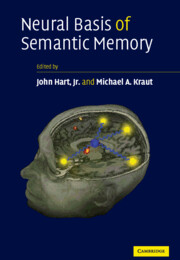Book contents
- Frontmatter
- Contents
- List of contributors
- Preface
- Part I Semantic Memory: Building Models from Lesions
- Part II Insights from Electrophysiology
- Part III Applications of Models to Understanding Cognitive Dysfunction
- 5 Schizophrenia and semantic memory
- Part IV Representations of Nouns and Verbs vs. Objects and Actions
- Part V Critical Role of Subcortical Nuclei in Semantic Functions
- Part VI Conceptual Models of Semantics
- Index
- References
5 - Schizophrenia and semantic memory
from Part III - Applications of Models to Understanding Cognitive Dysfunction
Published online by Cambridge University Press: 14 September 2009
- Frontmatter
- Contents
- List of contributors
- Preface
- Part I Semantic Memory: Building Models from Lesions
- Part II Insights from Electrophysiology
- Part III Applications of Models to Understanding Cognitive Dysfunction
- 5 Schizophrenia and semantic memory
- Part IV Representations of Nouns and Verbs vs. Objects and Actions
- Part V Critical Role of Subcortical Nuclei in Semantic Functions
- Part VI Conceptual Models of Semantics
- Index
- References
Summary
Schizophrenia is a severe, chronic, and disabling psychiatric illness that affects 1 percent of the population. It is often characterized by disorganized speech, delusions, hallucinations, disorganized or catatonic behavior, and negative symptoms such as flat affect and avolition (Diagnostic and statistical Manual of Mental Disorders, 4th edn. – DSM-IV). The symptoms related to disorganized and incoherent speech are also known as formal thought disorder (FTD). Although symptoms may vary from patient to patient and between different episodes of the illness in the same patient, 90 percent of the patients show FTD symptoms at some point during the course of their illness (Andreasen, 1979b). Even though these symptoms have been considered to be fundamental to schizophrenia since first described by Bleuler (Bleuler, 1911) and Kraepelin (Kraepelin et al., 1919), the cognitive impairments associated with the neurobiology of FTD are still a matter of debate. One of the most influential theories to date suggests that FTD is strongly associated with impaired semantic memory processing (Spitzer, 1997; Goldberg et al., 1998; Kerns & Berenbaum, 2002). In this chapter we will review the clinical and cognitive symptoms related to FTD, the evidence available that supports different aspects of semantic impairments in FTD, and recent data from our lab suggesting that a far-spreading activation theory within the semantic system is the core, underlying deficit resulting in FTD.
Formal thought disorder
As mentioned above, the symptoms of FTD have been considered by some investigators as pathognomonic to schizophrenia.
Keywords
- Type
- Chapter
- Information
- Neural Basis of Semantic Memory , pp. 133 - 146Publisher: Cambridge University PressPrint publication year: 2007
References
- 1
- Cited by



